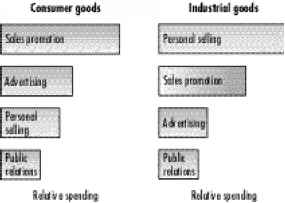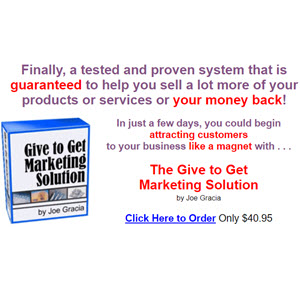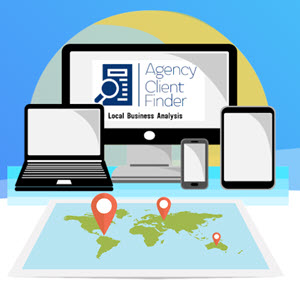Step 6 Developing and Managing the Marketing Communications Mix
Having established a communications budget, companies must decide how to allocate it over the five promotional tools. Companies differ considerably in their allocations, even within the same industry. Avon concentrates its promotional funds on personal selling, whereas Cover Girl spends heavily on advertising. Still, because companies are always searching for more efficiency by substituting one promotional tool for another, they must be careful to coordinate all of their marketing functions.
Promotional Tools
Each promotional tool has its own unique characteristics and costs.12
^ Advertising. Advertising can be used to build up a long-term image for a product (Coca-Cola ads) or trigger quick sales (a Sears ad for a weekend sale). Advertising can reach geographically dispersed buyers efficiently. Certain forms of advertising (TV advertising) typically require a large budget, whereas other forms (newspaper advertising) can be done on a small budget. We discuss advertising in more detail later in this chapter.
^ Sales promotion. Although sales-promotion tools—coupons, contests, premiums, and the like—are highly diverse, they offer three distinctive benefits: (1) communication (they gain attention and usually provide information that may lead the consumer to the product); (2) incentive (they incorporate some concession or inducement that gives value to the consumer); and (3) invitation (they include a distinct invitation to engage in the transaction now). Sales promotion can be used for short-run effects such as dramatizing product offers and boosting sales. Later in this chapter we discuss sales promotion in more detail.
^ Public relations and publicity. The appeal of public relations and publicity is based on three distinctive qualities: (1) high credibility (news stories and features are more authentic and credible than ads); (2) ability to catch buyers off gguard (reach prospects who prefer to avoid salespeople and advertisements); and (3) dramatization (the potential for dramatizing a company or product). This underused technique is examined later in this chapter.
^ Personal selling. Personal selling has three distinctive qualities: (1) personal confrontation (it involves an immediate and interactive relationship between two or more persons); (2) cultivation (it permits all kinds of relationships to spring up, ranging from a matter-of-fact selling relationship to a deep personal friendship); and (3) response (it makes the buyer feel under some obligation for having listened to the sales talk).
^ Direct marketing All forms of direct marketing—direct mail, telemarketing, Internet marketing—share four distinctive characteristics: They are (1) nonpublic (the message is normally addressed to a specific person); (2) customized (the message can be prepared to appeal to the addressed individual); (3) up-to-date (a message can be prepared very quickly); and (4) interactive (the message can be changed depending on the person's response).
Factors in Setting the Marketing Communications Mix
Companies must consider several factors in developing their promotion mix:
^ Type of product market. As Figure 5-6 shows, promotional allocations vary between consumer and business markets. Although advertising is used less than sales calls in business markets, it still plays a significant role in building awareness and comprehension, serving as an efficient reminder of the product, generating leads, legitimizing the company and products, and reassuring customers about their purchases. Personal selling can also make a strong contribution in consumer-goods marketing by helping to persuade dealers to take more stock and display more of the product, build dealer enthusiasm, sign up more dealers, and grow sales at existing accounts.
^ Push-versuspull strategy. A push strategy involves the manufacturer using sales force and trade promotion to induce intermediaries to carry, promote, and sell the product to end users. This is especially appropriate where there is low brand loyalty

- Figure 5-6 Relative Spending on Promotional Tools in Consumer versus Business Markets
in a category; brand choice is made in the store; the product is an impulse item; and product benefits are well understood. A pull strategy involves the manufacturer using advertising and consumer promotion to induce consumers to ask intermediaries for the product, thus inducing the intermediaries to order it. This is especially appropriate when there is high brand loyalty and high involvement in the category; people perceive differences between brands; and people choose the brand before they go to the store.
^ Buyer-readiness stage. Promotional tools vary in cost effectiveness at different stages of buyer readiness, as shown in Figure 5-7. Advertising and publicity play the most important roles in the awareness-building stage. Customer comprehension is affected primarily by advertising and personal selling, while customer conviction is influenced mostly by personal selling. Closing the sale is influenced mostly by personal selling and sales promotion. Reordering is also affected mostly by personal selling and sales promotion, and somewhat by reminder advertising.
^ Product-life cycle stage. Promotional tools also vary in cost effectiveness at different stages of the product life cycle. Advertising and publicity are most cost effective in the introduction stage; then all the tools can be toned down in the growth stage because demand is building word of mouth. Sales promotion, advertising, and personal selling grow more important in the maturity stage. In the decline stage, sales promotion continues strong, advertising and publicity are reduced, and salespeople give the product only minimal attention.
^ Company market rank. Market leaders derive more benefit from advertising than from sales promotion. Conversely, smaller competitors gain more by using sales promotion in their marketing communications mix.
Continue reading here: Major Decisions in Sales Promotion
Was this article helpful?

